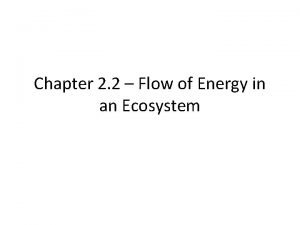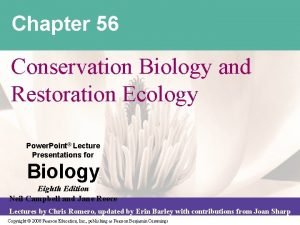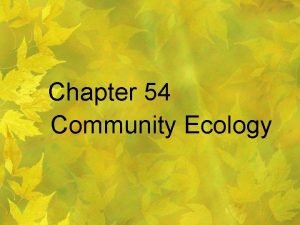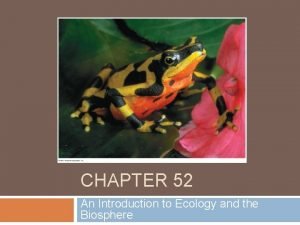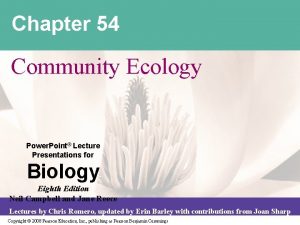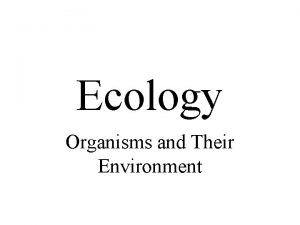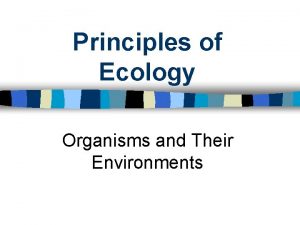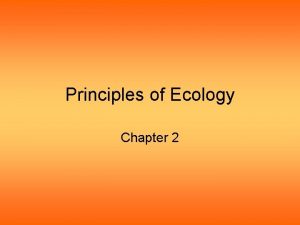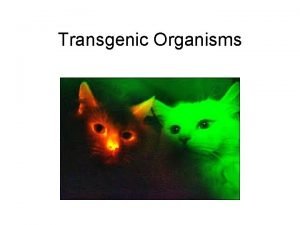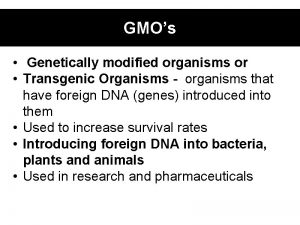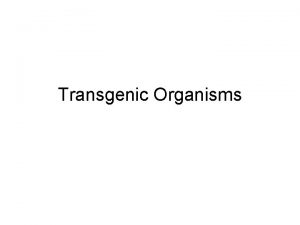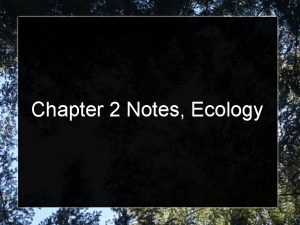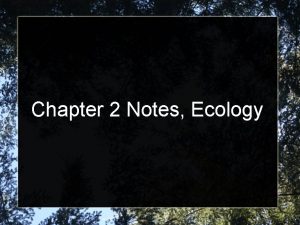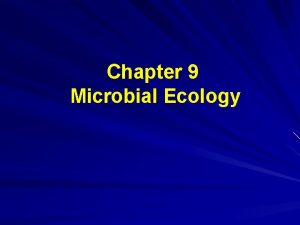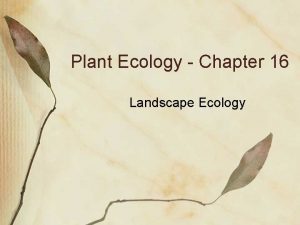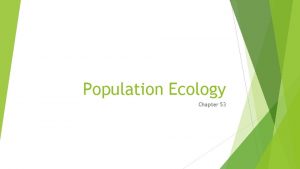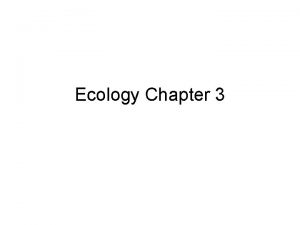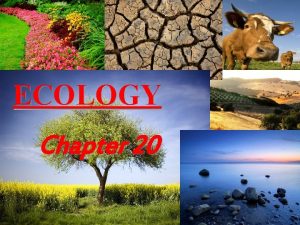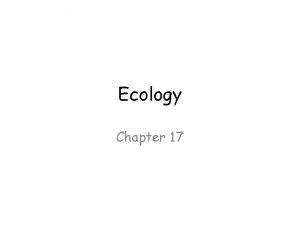Chapter 2 Principles of Ecology 2 1 Organisms



























- Slides: 27

Chapter 2 – Principles of Ecology

2. 1 Organisms and Their Relationships

Vocabulary List ecology biosphere biotic factor abiotic factor population biological community ecosystem biome habitat niche predation symbiosis mutualism commensalism parasitism

Ecology • Organisms depend on each other in all types of environments — deserts, tropical rain forests, and grassy meadows.

Ecology • The study of the interactions between organisms and their environments

What is Biosphere?

What is Biosphere? • The thin layer of air, land, and water on or near Earth’s surface in which all living things on Earth exist.

What is Biosphere? • The biosphere supports a wide variety of organisms in a wide range of environments.

What is Biosphere? Every environment, such as a rainforest, contains living and non-living factors (components)

LIVING factors = BIOTIC factors Plants Animals Fungi Bacteria NON - LIVING factors = ABIOTIC factors Sunlight Soil Moisture Temperature

Levels of Organization • The biosphere is too large to study all the relationships at one time. • We use smaller pieces, or levels of organization, for their studies. 1. organism 2. population 3. biological community 4. ecosystem 5. biome 6. biosphere

Organisms, Populations, and Biological Communities Organisms An individual living thing, such as one striped fish

Organisms, Populations, and Biological Communities Population A group of organ isms of the same species that interbreed and live in the same place at the same time, such as the school of striped fish, is a population.

Organisms, Populations, and Biological Communities Community All of the populations of species (fishes, coral, and marine plants) that live in the same place at the same time

Ecosystems, biomes, and the biosphere Ecosystems A biological community, such as the coral reef, and all of the abiotic factors, such as the sea water, that affect it.

Ecosystems, biomes, and the biosphere Biome A biome is formed by a group of ecosystems (the coral reefs off the coast of the Florida Keys) that share the same climate and have similar types of communities.

Ecosystems, biomes, and the biosphere Biosphere The highest level of organization is the biosphere composed of many biomes

Ecosystem Interactions Ø Organisms increase their chances of survival by using available resources in different ways. Ø Birds might use a tree for shelter, while insects use the tree’s leaves for food.

Ecosystem Interactions - Habitat ØA habitat is an area where an organism lives ØAn insect might spend its entire life on one tree. Its habitat is that tree. ØA bird flies from tree to tree. Its habitat is the grove of trees.

Ecosystem Interactions - Niche Ø Organisms also have a niche. Ø A niche is the role an organism has in its environment Ø It is how the species meets its specific needs for food and shelter. Ø It is how and where the species survives and reproduces.

Community Interactions Ø Organisms living in biological communities interact constantly. Ø Each organism depends on other organisms and competes with other organisms. Competition Predation Symbiosis

When do organisms compete? Ø Competition occurs when organisms need to use the same resource at the same time. Ø It is for food, water, space, and/or light. Ø When strong organisms compete with weak organisms, the strong organisms usually survive.

What is predation? Ø It is the act of one organism consuming another organism for food Ø Most organisms obtain their food by eating other organisms. Ø The organism that pursues is the predator. Ø The organism that is pursued is the prey.

What is symbiosis? Ø Some species survive because of relationships with other species Ø A relationship in which two organisms live together in close association is called symbiosis Mutualism Commensalism A relationship between two species that live together and benefit t from each other One organism is helped and the other organism is not harmed or helped Parasitism One organism benefits and another organism is harmed

CLASSWORK/HOMEWORK � 2. 1 Reading Notes (Tuesday, April 22) � 2. 1 Study Guide (Tuesday, April 22) �How Does Your Biome Grow LAB � 2. 1 QUIZ , Wednesday, April 23

Possible Biomes and Abiotic Factors 1) 2) 3) 4) How does wavelength impact a biome How does a type of soil impact a biome How does wind impact a biome How does CO 2 level affect impact a biome

 Principles of ecology chapter 2
Principles of ecology chapter 2 Principles of ecology organisms and their relationships
Principles of ecology organisms and their relationships Organisms ecology
Organisms ecology Principles of ecology section 3 cycling of matter
Principles of ecology section 3 cycling of matter Principles of ecology chapter 2
Principles of ecology chapter 2 Principles of ecology section 2 flow of energy
Principles of ecology section 2 flow of energy Why do organisms interact with other organisms
Why do organisms interact with other organisms Multi and unicellular organisms
Multi and unicellular organisms Chapter test a chapter 4 population ecology answer key
Chapter test a chapter 4 population ecology answer key Principles of ecology 2 flow of energy in an ecosystem
Principles of ecology 2 flow of energy in an ecosystem Marine ecology
Marine ecology Chapter 3, section 1: community ecology answer key
Chapter 3, section 1: community ecology answer key Chapter 56 conservation biology and restoration ecology
Chapter 56 conservation biology and restoration ecology Chapter 55 ecosystems and restoration ecology
Chapter 55 ecosystems and restoration ecology Chapter 54: community ecology answer key
Chapter 54: community ecology answer key Chapter 53 population ecology
Chapter 53 population ecology Chapter 52 an introduction to ecology and the biosphere
Chapter 52 an introduction to ecology and the biosphere Chapter 5 evolution and community ecology
Chapter 5 evolution and community ecology Equilibrial life history
Equilibrial life history Chapter 4 population ecology answer key
Chapter 4 population ecology answer key Chapter 54 community ecology
Chapter 54 community ecology Chapter 53 population ecology
Chapter 53 population ecology Chapter 55 ecosystems and restoration ecology
Chapter 55 ecosystems and restoration ecology Chapter 5 evolution and community ecology
Chapter 5 evolution and community ecology Chapter 5 evolution and community ecology answer key
Chapter 5 evolution and community ecology answer key Chapter 4 section 1 population dynamics study guide
Chapter 4 section 1 population dynamics study guide Chapter 4 section 2 human population answer key
Chapter 4 section 2 human population answer key Chapter 53 population ecology
Chapter 53 population ecology









